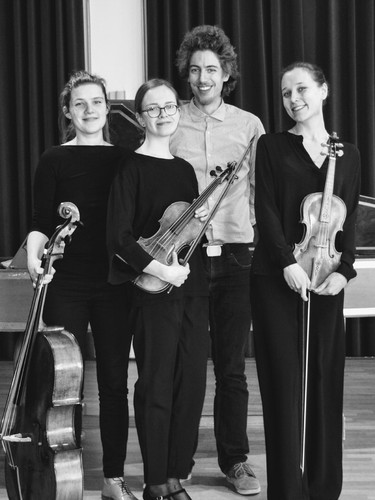Ensemble Pagliacci
Ensemble Pagliacci
Vita
Bremen (Deutschland), Basel (Schweiz), Utrecht (Niederlande)
Das Ensemble Pagliacci hat sich 2018 zusammengefunden. Die Musiker, die aus Deutschland, den Niederlanden, Russland und der Schweiz stammen, haben bereits in verschiedenen Konstellationen zusammengespielt. Dabei war die Musik C.P.E. Bachs von zentraler Bedeutung. So haben drei der Mitglieder unter dem Namen Wotquenne Quartett mehrfach die Flötenquartette C.P.E. Bachs aufgeführt, z.B. auch im Rahmen der Fringe Konzerte des Oude Musieck Festivals 2017. Die neue Zusammenstellung, hat Pagliacci nicht nur ein besonders reichhaltiges Spektrum an Repertoire eröffnet, sondern verbindet auch den Einfluss unterschiedlicher Schulen wie der Schola Cantorum Basiliensis und der Akademie für Alte Musik Hfk Bremen miteinander. Bei der Auswahl der Musik liegt dem Ensemble besonders die Gleichberechtigung der Instrumente und Spieler am Herzen. Mit ihren Konzerten wollen Pagliacci die Vielseitigkeit der Instrumentalmusik abbilden und Vorzüge, wie
Facettenreichtum eines jeden Instrumentes zum Vorschein bringen. Davon erhoffen sich die Mitglieder dem Publikum ein spannendes, abwechslungs- und farbenreiches Programm bieten zu können.
The Early Music Ensemble Pagliacci came together in 2018. Its members, Sevastyana Leonova and Anna Amstutz (baroque violin), Barbara Hartrumpf (baroque cello) and Tim Veldman (harpsichord), who are all of a different nationality, were no strangers however, since they performed together in varying constellations. In their concerts, Carl Philipp Emanuel Bach has always had a key role. Under the name Wotquenne Quartett, three of the present four performed Bachs complete quartets various times, for example in the Fringe series of the Festival Oude Muziek Utrecht. Its new line-up has opened up to Pagliacci all kinds of exciting new repertoire and is a bridge between the styles of the Schola Cantorum Basiliensis and the Akademie für Alte Musik Bremen. In the choice of pieces for its programmes, Pagliacci looks for an equal division of interest between its parts, keeping all its members sharp and leaving the audience dazzled from all sides. Its aim is to bring out the individual qualities of each instrument and explore how these work together to recreate the sounds of the past.
Besetzung
Leonova Sevastyana, Violine
Anne Noel Amstutz, Violine
Barbara Hartrumpf, Violoncello
Tim Feldman, Cembalo
Programm
1. Runde
Élisabeth Jacquet de la Guerre (1665-1729)
Sonate für 2 Violinen, Violoncello obbligato und Basso continuo Nr. 2 c-Moll
Grave – Vivace – Largo – Vivace – Aria affetuoso/Allegro/Adagio
Wilhelm Friedemann Bach (1710-1784)
Triosonate B-Dur F. 50
Largo – Allegro ma non troppo – Vivace
Luc Marchand (1709 – 1799)
Sixième Suite de clavecin accomp. avec violoncelle
„Le labirinth harmonique“, „Le folies franceties“, „Le spectacle des mains“
2. Runde
Carl Philipp Emanuel Bach (1714-1788)
Triosonate c-Moll Wq 161/1 H. 579 „Sanguineus et Melancholicus“
Allegretto/Presto – Adagio – Allegro
Giovanni Benedetto Platti (1697-1763)
Concerto con Violoncello obligato WD 663 g-Moll
Grave – Allegro – Largo e staccato - Allegro
Jean Philippe Rameau (1683-1764)
Pièces de clavecin en concerts, IVe Concert B-Dur RCT (Bearbeitung für 2 Violinen, Violoncello und Cembalo)
La Pantomime (Loure vive) – L´Indiscrette (Vivement) – La Rameau
